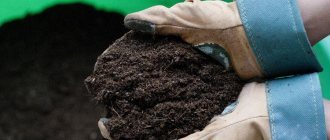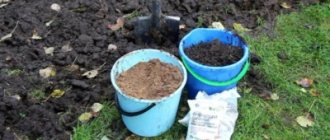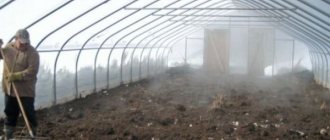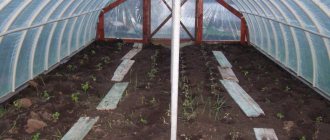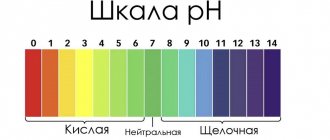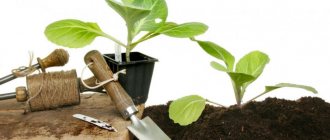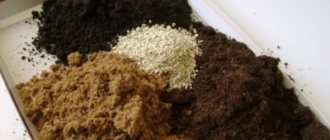Rather than worry about the quality of the substrate in which the seedlings will grow, it is better to immediately disinfect the soil before planting the seeds.
Dear readers!
For you, we have created communities on social networks in which useful articles and interesting ideas are published several times a day! Subscribe and receive useful content in a convenient format! This will eliminate many problems associated with the subsequent fight against diseases of seedlings and insect pests.
In this article we will talk about different methods of soil disinfection and find out which one is the most effective.
Why disinfect soil?
Many will ask: “Is it really necessary to disinfect the soil before planting seeds and planting seedlings?”
The short answer is yes.
The fact is that spores of pathogenic fungi, viruses and bacteria that attack plants can live in the soil. If they are not destroyed, then there will be problems during cultivation.
This is especially true when using garden soil as a component of the substrate for seedlings.
Garden soil is simply a breeding ground for a wide variety of pathogens. They overwinter in the soil. In addition, there may be larvae and egg clutches of pests here.
This is also why it is not recommended to use garden soil for planting seedlings.
Now about store-bought substrate.
In general, a conscientious manufacturer must take care to properly prepare the soil before selling. That is, ideally, purchased land does not need to be disinfected.
But often even such land is contaminated.
So it’s better to treat it too. Moreover, the procedure will not take too much time.
Freezing
The proverb “prepare a sleigh in summer and a cart in winter” is suitable for this method. If the gardener takes care of replanting indoor plants in advance, the soil can be frozen. The soil is placed on an open balcony in winter. It is better to time it when the temperature outside is -20°C. And they leave him there for two weeks. When the ground freezes thoroughly, it is brought to a warm place and left to warm up. During this time, insect larvae and pupae wake up, and the same happens with weed seeds. And then the soil is again placed in harsh cold conditions. It is better to repeat the temperature change procedures several times.
If winter is not frosty or it’s spring outside and the soil is not prepared, use the freezer. To do this, the soil is distributed into bags and placed at a distance from each other in the freezer. The temperature is set to the lowest.
At minimum thermometer values, some bacteria and fungi die, and weed larvae and seeds are completely destroyed.
What methods of soil treatment are there?
There are many ways to disinfect the soil. Let's look at each of them in more detail.
Thermal treatment of the soil before planting
Probably the simplest way to disinfect the soil before sowing seeds for seedlings is heat treatment.
We’ll talk about cold disinfection below, but now let’s talk about high-temperature treatment, namely calcination and steaming.
Calcination
During this procedure, the soil for the seedlings is heated on a baking sheet. Calcination is carried out as follows: pour the soil onto a baking sheet in a layer of 4-5 cm and place in the oven. Keep for half an hour at a temperature of 90 degrees.
Among the disadvantages of this method, it is worth mentioning the chance to destroy not only pathogenic, but also beneficial microflora. Eventually the land will become infertile and nothing can be grown in it.
Steaming
This method involves scalding the ground with hot steam or boiling water. To steam the soil, place it in a canvas bag and place it over boiling water.
IMPORTANT!
After heat treatment, the soil must be allowed to cool and become saturated with oxygen. To do this, sprinkle it evenly on the surface in a layer of 5 cm and let cool.
How to disinfect with cold
In addition to heat treatment, soil can be disinfected using cold. Or rather, using freezing.
To disinfect the soil for growing vegetables with cold, it is taken out to frost below -15 degrees. The substrate must be kept at this temperature for 7 days. Then the soil is warmed up and frozen again.
The disadvantage of this method is that it does not destroy the spores of the most common fungus - late blight.
How to treat with drugs or chemicals
The substrate can be disinfected by treating it with chemicals. This is a highly effective method, but it is used only when all other safer methods have failed.
Bleaching powder
An effective substance that burns out almost all pathogenic microflora. It is necessary to cultivate the land six months before planting the seedlings.
If you use garden soil, then in fact the treatment with bleach should be carried out immediately after the end of the summer season. Treatment rates are 200 grams of bleach per square meter of land.
The downside is that not all cultures take root.
Formalin
Apply 15 days before sowing. To make the substance work better, place the soil under cover for 3-4 days.
Formalin is very effective against blackleg.
TMTD
The advantage of this substance is that it is harmless to seedlings. The treatment is carried out before planting. Both suspension and powder can be used.
Biological soil disinfection
The optimal solution for soil treatment is the use of biological preparations. They not only destroy pathogenic microflora, but also saturate the soil with nutrients, making it more suitable for planting.
Trichodermin
An antibiotic that destroys pathogenic microflora. Effective in disinfecting contaminated garden soil. For every kilogram of soil you need only 1 gram of trichodermin dissolved in water.
Baikal EM-1
The working solution is prepared from 150 ml of the drug and 10 liters of water. For every square meter of land, 2.5 liters of working solution are consumed. Can be used before planting seeds and at the end of the summer season.
Alirin-B
A means for destroying fungi that cause root rot. For 2.5 liters of water you only need half a tablet of water. You can water the soil even after planting.
Fitosporin-M
One of the most effective and safe drugs. It is equally useful for disinfecting the soil when planting seeds and for disinfecting the soil before planting seedlings in the garden.
Fitosporin not only destroys pathogens, but also increases plant resistance to disease.
How to use folk remedies
Folk remedies, by and large, are not as effective as store-bought drugs. But they are beneficial because they are cheap, and also because they are environmentally friendly and do not harm plants.
Potassium permanganate solution
Just 5 grams of potassium permanganate is enough for a bucket of water, which can be used to treat the entire garden. For seedlings, you can prepare a solution from just 1 crystal.
Garlic solution
This remedy is effective mainly against insect larvae, but at the same time suppresses the development of pathogenic microflora. To prepare the concentrate, crush 1 head of garlic and pour a liter of boiling water. Insist for a week.
For the working solution, only 50 ml of concentrate is used.
You can disinfect the soil before planting seedlings, or you can treat the garden if you suspect the presence of pests.
Ash infusion
Pour 150 grams of ash into a liter of water, boil and let it brew. Remove the top layer, dissolve it in water in a ratio of 1 to 2 and water the soil under the seedlings.
Calcination
Firing is carried out in the oven. To do this, place the soil in a fireproof container or baking sheet, first covering it with parchment. The soil is thoroughly poured with boiling water and covered with foil on top. The optimal thickness of the soil to be heated is 10 cm. The oven is heated, but not higher than 90 degrees, otherwise toxins will form in the soil and all beneficial microflora will be destroyed. The process lasts about half an hour, then the earth is left to cool and become saturated with oxygen.
Baking the soil is a variant of calcination. The earth is evenly distributed over the baking sleeve and closed with flexible brackets. Further actions correspond to the calcination process. In this case, moisture from the soil does not evaporate, but rather completely saturates and saturates it.
How to disinfect the soil before planting seedlings
Compared to gardening, very little soil is required for planting seedlings, so it is better to use the thermal method, a solution of potassium permanganate and Fitosporin-M.
Before planting seedlings, the soil can be calcined in the oven, and then watered with Fitosporin or Baikal. This will not only help you destroy harmful microorganisms, but will also saturate the soil with useful microelements and make it more nutritious.
ON A NOTE.
Purchased soil from a trusted manufacturer can simply be watered with Fitosporin solution.
Components that improve the quality of the soil mixture
To improve the quality of homemade or purchased soil, organic and inorganic substances can be used.
Organic
This includes additives of animal or plant origin. This could be sawdust, vegetable peelings, droppings, manure, humus, and so on. Before using organic matter to improve the properties of the soil, it needs to sit for about 6 months.
Inorganic
Inorganics include mineral fertilizers, which can be purchased in specialized stores. There are a number of qualities in which they are significantly superior to organic substances in terms of their effectiveness on the soil mixture.
Inorganic components can be simple, containing 1 mineral element, or complex, that is, including several (at least 2) elements.
In recent years, there have been many complaints from customers about the fact that instead of a good soil mixture, many fakes containing stones and branches have appeared. Therefore, it is always better to buy soil for testing. If the results are good, then you can continue to use it.
Tillage in open ground
Growing seedlings ends with planting them in open ground. To protect seedlings from pathogenic microorganisms, the soil can also be treated.
Since garden soil is difficult to thermally disinfect, it is disinfected using chemical or biological agents. The following drugs are suitable:
- Bleaching powder;
- Formalin (200 ml per bucket of water per square meter 2 weeks before planting);
- TMTD (disinfection should be carried out immediately before disembarkation);
- Copper sulfate (disinfection is carried out before winter after the end of the summer season);
- Baikal EM-1;
- Alirin-B;
- Fitosporin-M;
- Infusion of ash.
Potassium permangantsovka
Treatment with a solution of potassium salt of permanganic acid is the simplest and fastest way to disinfect soil. Three grams of potassium permanganate are dissolved in a ten-liter bucket of water to form a faint pink suspension. The liquid is carefully poured onto the soil to be disinfected, centimeter by centimeter. Potassium permanganate is also used to treat pots and containers for seedlings.
Manganese, when it gets into the ground, saturates it with useful substances - it becomes a fertilizer.
Potassium permanganate is not able to destroy all pathogens, so this method is considered ineffective. To enhance soil disinfection, the container with the treated soil is covered with cellophane film and kept for a week. Under such conditions, pathogenic microflora die, and the soil is saturated with moisture and microelements.
How to process and with what after different crops
Various vegetable and berry crops leave behind pathogenic microflora. Therefore, the soil is treated before new planting.
- After tomatoes, peppers and eggplants - copper sulfate, Trichodermin, Fitosporin.
- After potatoes – Fitosporin.
- After cucumbers, pumpkins and zucchini - Fitosporin, boric acid.
ON A NOTE.
You can also plant green manure; they not only suppress the development of pathogenic microflora, but also have a beneficial effect on the soil.
How to till the soil at different times of the year
In general, the soil requires regular maintenance throughout the year. Let's look at how to care for the soil throughout the season.
- Spring.
The first treatment is carried out immediately after the snow melts. At this time, you can use either folk substances or “chemistry”. Biological preparations are not suitable, since the bacteria in them are activated only at high temperatures. Optimal substances: solution of potassium permanganate, copper sulfate, bleach. - Summer.
Summer disinfection is carried out as needed. At this time of year it is better to use biologically active drugs. For example, Fitosporin-M, Baikal EM-1. They will not only fight pathogens, but will also have a beneficial effect on plants. - Autumn.
After harvesting, if the weather permits, it can be disinfected with biological preparations. If not, use copper-containing products and ash solution.
Common mistakes
- High temperature during heat treatment.
You cannot exceed the value of 90 degrees and the time of 20-30 minutes if you do not want to destroy the substrate for the seedlings. - After calcination and freezing, the soil is not renewed with nutrients.
If you choose a thermal method to disinfect the soil, then be sure to treat it with biological agents to restore its fertility. - Using large amounts of copper sulfate.
Copper in large quantities harms plants, so precautions must be taken when preparing the working solution. - Mixing chemicals and biologically active substances.
“Chemistry” will kill not only pathogens, but also beneficial bacteria. As a result, the land will be infertile. - Use of land that has already been used.
Along with errors in the use of disinfection methods, a summer resident often tries to save money and uses soil for seedlings that has already been used under plants. This cannot be done not only because the land may be contaminated, but also because it will no longer be so fertile.
General requirements for soil mixtures
Almost all soil mixtures contain peat. True, it is simply ineffective as a fertilizer, since it contains a low amount of nutrients. The exception is nitrogen: its content is high, but it is difficult to assimilate by cultivated crops. Earthen peat should be used only in combination with other beneficial substances.
When collecting peat yourself, it is important to consider that only the one that is at depth can be used for plants. The top layer is not suitable because its pH is very high. But there is a separate spectrum of plants that need peat with a high level of acidity. These are flowers: hydrangea, rhododendron, and also blueberry.
Peat can be used alone if the land itself at the dacha contains a lot of clay and sand. Then it won't hurt to dilute them. But if the land is fertile, then adding peat alone without other nutrients will be absolutely useless.
The soil mixture must meet all those characteristics that are necessary for the normal growth and development of seedlings:
- Freely allow the required amount of moisture and air to pass through.
- Contain the right amount of nutrients. However, it is important to remember that their excess harms the seedlings.
- Be loose.
- Have a neutral or slightly acidic level.
- Must not contain fungal spores, harmful microorganisms (including insect eggs and larvae), weed seeds and any toxic substances.
It is strictly prohibited to use ready-made soil for seedlings in greenhouses and greenhouses if it was previously used for growing tomatoes and peppers.
What should not be in the soil for seedlings
Despite the “living” microflora, the soil should not contain insect larvae, weed seeds, or harmful microorganisms. The soil should not contain toxic substances, clay or other compounds unsuitable for growing seedlings. You should also pay attention to the presence of organic components in the soil. An excess of such elements will negatively affect plant health, because the soil will intensively lose nitrogen. In addition, decomposing substances contribute to an increase in soil temperature, which will lead to disease or, even worse, death of the plant root system.
Answers to frequently asked questions
Is it necessary to disinfect purchased substrate?
Preferably. In general, the manufacturer guarantees that the soil has been completely disinfected at the factory. But sometimes it’s better to be safe than sorry.
What is the most effective way to disinfect soil?
Some types of fungi are able to survive in the cold. But the probability of infection of purchased land with such disputes is very low.
If you decide to disinfect a purchased substrate, you can use any method.
It is better to calcinate garden soil in the oven and water it with antifungal compounds.
Do I need to use several methods or will just one be enough?
In general, one cultivation of the land for seedlings will be enough.

